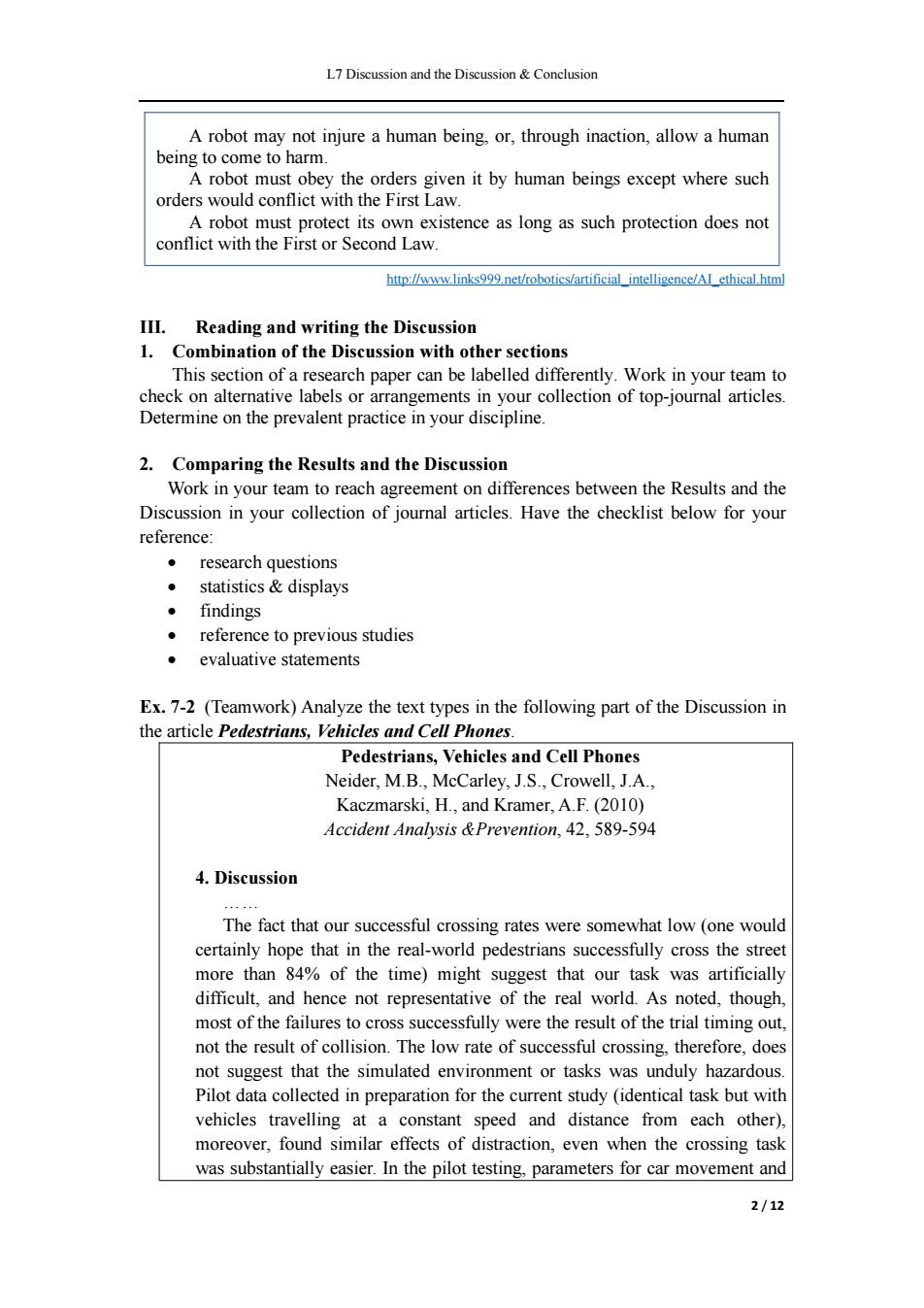正在加载图片...

L7 Discussion and the Discussion Conclusion A robot may not injure a human being,or,through inaction,allow a human being to come to harm. A robot must obey the orders given it by human beings except where such orders would conflict with the First Law. A robot must protect its own existence as long as such protection does not conflict with the First or Second Law. http://www.links999.net/robotics/artificial intelligence/AI ethical.html III.Reading and writing the Discussion 1.Combination of the Discussion with other sections This section of a research paper can be labelled differently.Work in your team to check on alternative labels or arrangements in your collection of top-journal articles. Determine on the prevalent practice in your discipline. 2.Comparing the Results and the Discussion Work in your team to reach agreement on differences between the Results and the Discussion in your collection of journal articles.Have the checklist below for your reference: research questions ● statistics displays ● findings reference to previous studies evaluative statements Ex.7-2 (Teamwork)Analyze the text types in the following part of the Discussion in the article Pedestrians,Vehicles and Cell Phones. Pedestrians,Vehicles and Cell Phones Neider,M.B.,McCarley,J.S.,Crowell,J.A. Kaczmarski,H.,and Kramer,A.F.(2010) Accident Analysis &Prevention,42,589-594 4.Discussion 。。。 The fact that our successful crossing rates were somewhat low (one would certainly hope that in the real-world pedestrians successfully cross the street more than 84%of the time)might suggest that our task was artificially difficult,and hence not representative of the real world.As noted,though most of the failures to cross successfully were the result of the trial timing out, not the result of collision.The low rate of successful crossing,therefore,does not suggest that the simulated environment or tasks was unduly hazardous. Pilot data collected in preparation for the current study(identical task but with vehicles travelling at a constant speed and distance from each other), moreover,found similar effects of distraction,even when the crossing task was substantially easier.In the pilot testing,parameters for car movement and 2/12L7 Discussion and the Discussion & Conclusion 2 / 12 A robot may not injure a human being, or, through inaction, allow a human being to come to harm. A robot must obey the orders given it by human beings except where such orders would conflict with the First Law. A robot must protect its own existence as long as such protection does not conflict with the First or Second Law. http://www.links999.net/robotics/artificial_intelligence/AI_ethical.html III. Reading and writing the Discussion 1. Combination of the Discussion with other sections This section of a research paper can be labelled differently. Work in your team to check on alternative labels or arrangements in your collection of top-journal articles. Determine on the prevalent practice in your discipline. 2. Comparing the Results and the Discussion Work in your team to reach agreement on differences between the Results and the Discussion in your collection of journal articles. Have the checklist below for your reference: research questions statistics & displays findings reference to previous studies evaluative statements Ex. 7-2 (Teamwork) Analyze the text types in the following part of the Discussion in the article Pedestrians, Vehicles and Cell Phones. Pedestrians, Vehicles and Cell Phones Neider, M.B., McCarley, J.S., Crowell, J.A., Kaczmarski, H., and Kramer, A.F. (2010) Accident Analysis &Prevention, 42, 589-594 4. Discussion …… The fact that our successful crossing rates were somewhat low (one would certainly hope that in the real-world pedestrians successfully cross the street more than 84% of the time) might suggest that our task was artificially difficult, and hence not representative of the real world. As noted, though, most of the failures to cross successfully were the result of the trial timing out, not the result of collision. The low rate of successful crossing, therefore, does not suggest that the simulated environment or tasks was unduly hazardous. Pilot data collected in preparation for the current study (identical task but with vehicles travelling at a constant speed and distance from each other), moreover, found similar effects of distraction, even when the crossing task was substantially easier. In the pilot testing, parameters for car movement and